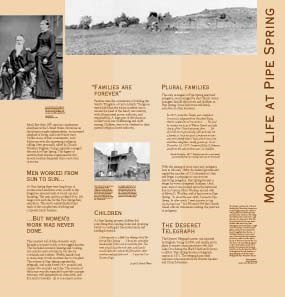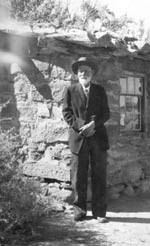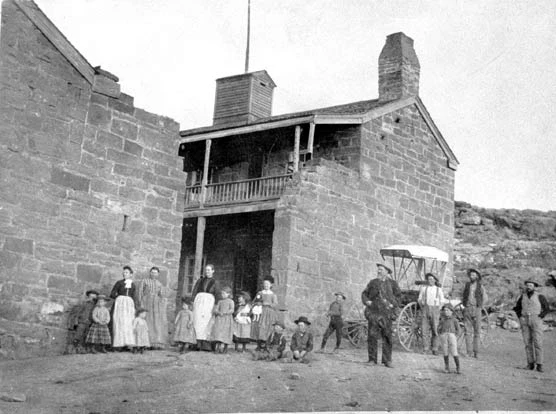
Men worked from sun to sun… At Pipe Spring there were long hours of routine ranch and farm work, as well as the dangerous seasonal tasks of round-ups and branding. The men and boys milked 80 to 100 range cows each day for the Pipe Spring dairy operation. The ranch superintendent kept track of the complexities of tithing and corporate ranch business. | ||
|
…But women's work was never done. The constant toil of daily domestic work brought a woman's touch to the rugged frontier. This included constant cleaning and cooking - not only for one's own family, but also for cowhands and workers. Weekly laundry had so many steps it took an entire day to complete. The women at Pipe Spring operated the telegraph, and made butter (40+ pounds) and cheese (60+ pounds) each day. The woman of the house was also expected to provide a proper welcome, well-prepared food, clean beds, and first aid for travelers - all at a moments notice.
Children At Pipe Spring, pioneer children did everything from hauling water and churning butter to cooking for the entire family and herding livestock. I did my part as a little boy helping build the fort at Pipe Springs...I drove the oxen that hauled part of the rock to build the fort. The men would load the rock onto a sled and I would drive the oxen to the fort where other workers unloaded the rock...I was but 7 or 8 years of age. Joseph F. (Frank) Winsor

|
Pipe Springs, a pioneer fort, is the most desolate place I have lived, situated on a point fronting an open desert, where it could get full force of the heavy winds and sandstorms common to the locality. I have known those sand storms to rage three days at a time, sand so thick that the opposite side of the fort was almost obscured. After every storm, house cleaning was necessary and from a single room I have swept or shoveled out five gallons of sand, the broom would not carry the weighty bulk to the door...I don't know how we ever came out of some of the hard places that conditions forced on us, unless as mother used to say, 'we do the best we can and the Lord does the rest. As stated Pipe Springs was a rather desolate place; at intervals in my life I have dreamed that I must go back there to live, the depression I felt at the thought and the utter loneliness of again taking up my life there made waking seem like a boon from heaven. Emma Seegmiller -
lived at Pipe Spring January 1891 to November 1896
The Deseret Telegraph The Deseret Telegraph system was initiated by Brigham Young in 1866, and rapidly put in place to ensure communications with Salt Lake City during the Black Hawk and Navajo conflicts. Pipe Spring became a telegraph station in 1871. The telegraph provided welcome communications for frontier families and Church business.
"Families are forever" Families were the cornerstone in building the Saint's "Kingdom of God on Earth." Religious tenets held that the Mormon father was to remain the head of the family into eternity, with all associated power, authority, and responsibility. A large part of the Mormon mother's role was childbearing and child rearing. Children were to be obedient to their parents' religious based authority. | |
|
Plural Families
| ||
|
The early managers of Pipe Spring practiced polygamy, as encouraged by the church. Some managers had all their wives and children at Pipe Spring. Some had wives and family members at other locations. Charles Pulsipher, 1877. Pulsipher was the second ranch superintendent at Pipe Spring; Julia was his third wife.
|
With the passing of more strict anti-polygamy laws in the early 1880s, the federal government tripled the number of U.S. Marshals in Utah and began a campaign to convict men practicing polygamy. Pipe Spring became a refuge for wives of targeted Southern Utah men, since it was located across the territorial line in Arizona. Flora Woolley, second wife of Edwin D. Woolley, said of her move to Pipe Spring, "So about the year 1886, I moved to Pipe Spring. In other words, I went to prison to keep my husband out." In 1890 and 1904 the Church issued official statements ending the practice of polygamy. | |

| ||
|
Florence Snow Woolley (first woman on the left) was the 2nd wife of Edwin D. Woolley (man in the center). Ellen Carling Chamberlain (third woman from the left), was the 4th wife of Thomas Chamberlain (man on the far right). Mary Jane McLeve Meeks (second woman from the left and a midwife) was the 2nd wife of Priddy Meeks. |
Ann Carling Chamberlain (she is not pictured, but is inside the fort having just had a baby, hence the need for the midwife) was the 3rd wife of Thomas Chamberlain and a sister to Ellen. From the mid 1880's to the mid 1890's at least 10 different plural wives hid out at Pipe Spring.
| |
Last updated: March 31, 2012
